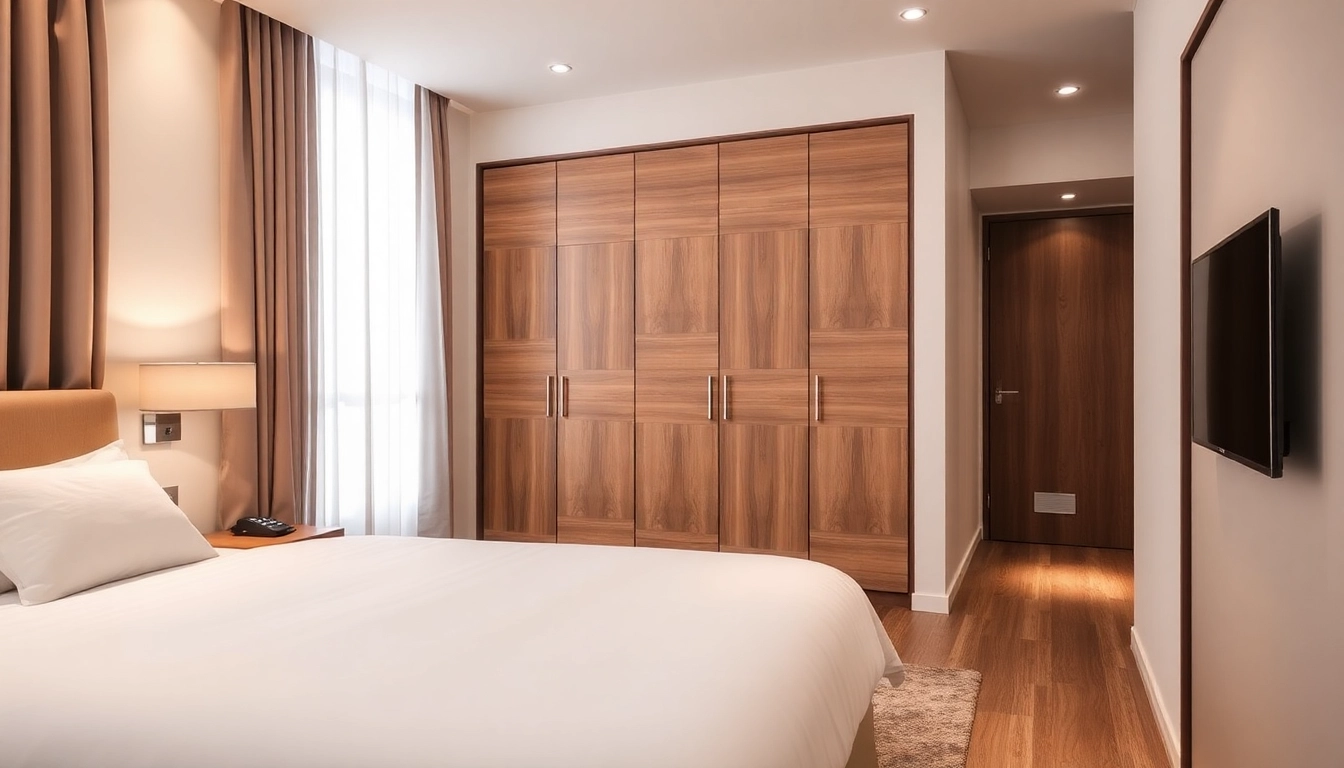Understanding Hotel Room Wardrobes
Definition and Importance
Hotel room wardrobes are essential pieces of furniture designed to provide both functionality and aesthetic appeal in guest accommodations. They are more than just storage spaces; they significantly contribute to the overall guest experience by ensuring that visitors have a convenient and organized way to store their belongings. The presence of a well-designed wardrobe can enhance a hotel’s reputation, reflecting the attention to detail and care that management has invested in creating a welcoming environment.
In a competitive hospitality industry, where guests often evaluate their stay based on comfort and convenience, a thoughtfully designed Hotel Room Wardrobes can be a distinguishing factor. They offer a refuge where guests can not only hang clothes but also store luggage, shoes, and accessories, creating a clutter-free environment that promotes relaxation.
Types of Hotel Room Wardrobes
Hotel room wardrobes come in various types, each designed to fulfill specific needs and aesthetic preferences:
- Built-in Wardrobes: These are integrated into the architecture of the room and maximize space efficiency. They often feature sliding or hinged doors and can be customized to include various compartments for clothes, shoes, and personal items.
- Freestanding Wardrobes: These can be placed anywhere in the room and are typically more versatile and mobile. They come in various designs and finishes, allowing hotels to select pieces that match their overall decor.
- Open Wardrobes: An emerging trend, open wardrobes eliminate traditional doors and create a more accessible storage space. This type may include hanging rods, shelves, and cubby spaces for shoes and other items, promoting a more casual and modern aesthetic.
- Modular Wardrobe Systems: Comprised of individual units that can be mixed and matched based on room size and guest needs, these systems provide flexibility and customization to cater to diverse clientele.
Key Features to Look For
When selecting wardrobes for hotel rooms, several key features should be considered to enhance functionality and guest satisfaction:
- Clothing Space: Ample hanging space for clothes is crucial. Consider incorporating both long and short hanging sections to accommodate different types of clothing.
- Shelving Options: Adjustable or fixed shelves can help guests organize their items effectively. Including drawers can also provide additional concealed storage space.
- Material Durability: Using high-quality materials that withstand frequent use is essential for longevity. Solid wood, metal, or high-grade laminates are popular choices.
- Design Aesthetics: Wardrobes should match the hotel’s design theme, whether modern, traditional, or eclectic. Color schemes and finishes play a critical role in visual harmony.
- Security Features: Adding a secure lock for personal items, especially in high-end hotels, can enhance guest confidence and convenience.
Design Trends in Hotel Room Wardrobes
Contemporary vs. Traditional Styles
The design of hotel room wardrobes varies significantly depending on current trends. Contemporary styles often favor minimalist aesthetics, which prioritize clean lines and functional space over excessive adornment. Materials like glass, polished metal, and simple wooden finishes are frequently used.
Conversely, traditional styles may feature more ornate details, such as carved wood and decorative moldings. These wardrobes create a luxurious feel and are appealing for hotels targeting a clientele that appreciates classic elegance.
Color Palettes and Material Choices
The choice of color palette can drastically affect the perception of a room. Neutral tones, such as whites, grays, and beiges, are popular for contemporary designs, providing a soothing atmosphere for guests. However, bursts of color in hardware or details can impact and complement the overall decor themes.
Material choices also reflect the branding of the hotel. Sustainable materials are gaining traction, as environmentally conscious travelers prioritize eco-friendly practices. Additionally, integrating textures—such as natural fibers or mixed materials—can add a unique touch that enhances visual appeal.
Space Optimization Techniques
With rooms often being limited in size, clever design strategies are crucial to maximizing every inch of available space:
- Sliding Doors: Opt for sliding doors instead of hinged ones to eliminate the need for swinging space, allowing for better flow within the room.
- Multi-Functionality: Consider designs with built-in benches or additional shelving above the wardrobe to utilize vertical space without overcrowding.
- Corner Solutions: Wardrobes designed for corners can make excellent use of often neglected spaces, providing extra storage without disrupting the room’s layout.
Choosing the Right Wardrobe for Your Hotel
Assessing Space and Room Design
Before selecting wardrobes, hotels should assess their available space carefully. Evaluating the dimensions and layout of each room can guide decisions regarding wardrobe size, type, and placement. Consideration must also be given to the potential for guest traffic and the overall flow, ensuring wardrobes do not block paths or disrupt comfort.
Considering the decor is equally vital. The wardrobe should harmoniously fit into the room while enhancing its functionality. Collaboration with interior designers can yield bespoke solutions that resonate with a hotel’s branding while maintaining guest comfort.
Budgeting for Hotel Furniture
Budget considerations are fundamental in the decision-making process. Establishing a clear budget for furniture not only involves the cost of wardrobes but also implementation, including logistics, installation, and potential future upgrades. Investing wisely can lead to long-term savings by selecting durable materials that withstand wear and tear.
Finding the balance between cost and quality is essential. Researching multiple suppliers, negotiating terms, and looking for deals while maintaining a focus on quality will ensure that the final investment enhances the guest experience without breaking the bank.
Supplier Recommendations and Collaborations
Partnering with reliable furniture suppliers can streamline the procurement process. Look for manufacturers who specialize in hotel furnishings and have a strong portfolio of successful projects. Gathering recommendations, reading reviews, and consulting case studies can assist in identifying trustworthy partners.
Cultivating relationships with suppliers can also lead to opportunities for customization that more generic providers may not offer. Unique designs and tailored functionalities can meet specific hotel needs and differentiate the establishment from competitors.
Maintenance and Care for Hotel Wardrobes
Cleaning Best Practices
Regular cleaning and maintenance play a crucial role in prolonging the life of hotel wardrobes. Recommended cleaning practices include:
- Routine Dusting: Dusting surfaces using a microfiber cloth can prevent buildup that can damage finishes over time.
- Stain Removal: Promptly addressing spills with appropriate cleaners ensures that stains do not set in, preserving the wardrobe’s appearance.
- Periodical Deep Cleaning: Engaging professionals to conduct thorough cleaning every so often can ensure all nooks and crannies are cared for.
Identifying Wear and Tear
Hotel staff should be trained to identify signs of wear and tear early. Common indicators include:
- Loose hardware, such as knobs or hinges, which can affect functionality.
- Scratches or dents that may detract from the visual appeal.
- Foul odors indicating mold or mildew, often near damp areas.
Timely Upgrades and Renovations
Periodic renovations are vital for maintaining a hotel’s reputation. Wardrobes that look dated or show signs of significant wear should be evaluated for either refurbishing or replacement. Upgrades can include simply changing hardware, applying new finishes, or investing in entirely new wardrobe systems. Regular assessments should be part of a comprehensive property management strategy to engage guests and preserve brand integrity.
The Future of Hotel Room Wardrobes
Innovative Design Features
The future of hotel room wardrobes is poised for innovation, with trends indicating a shift towards multifunctional furniture. New designs may incorporate technology such as built-in charging stations for electronic devices and smart mirrors that can display information like weather or flight statuses. Additionally, customizable layouts that allow guests to alter their storage solutions based on personal preferences are likely to become commonplace.
Guest Feedback and Customization
With hospitality becoming increasingly guest-centric, gathering feedback on wardrobe functionality and design preferences from guests can drive improvements. Smart hotels may engage guests in design choices, ensuring the environment aligns with the comfort and convenience they seek. Such personalization enhances overall guest experience and fosters brand loyalty.
Sustainable Practices in Wardrobe Manufacturing
The demand for sustainability continues to rise among consumers, leading hotels to seek eco-friendly manufacturing processes. Future wardrobes may utilize recycled materials, and manufacturers may adopt energy-efficient practices in production. Transparency in sourcing and addressing sustainability will remain crucial as guests become more conscientious about their impact on the environment.


